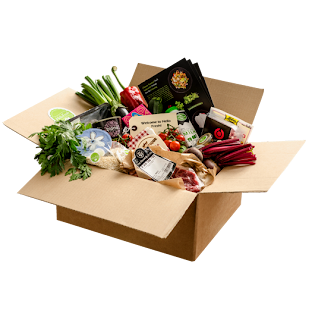 |
| Ready to cook dinner kit by Hello Fresh |
“There’s not enough time in modern lives to recipe-select or grocery-shop.”
Ready to cook people buy, measure, cut, chill, box and ship every ingredient to your door. All the home cook has to do, in theory, is click on “order,” open a box and follow a recipe.
This ready-to-cook meal is called the dinner
kit. These new services, including Blue Apron, Plated and HelloFresh, — is the latest in a stream of technological innovations and
corporate interventions, from the cake mix to the cookbook app, that have long
promised to relieve Americans of kitchen drudgery while retaining the flavor
and cachet of home cooking.
Home-delivered food, of course, is not news, and
neither is online shopping. Over the last decade, services like Peapod and FreshDirect have accustomed millions of consumers to buying
fresh ingredients online, while frozen-dinner delivery businesses like Schwan’s have sold them on fully prepared meals.
But the dinner kit aims for a sweet spot
somewhere between the bunch of asparagus and the finished asparagus-stuffed
salmon. And it addresses some paradoxes peculiar to today’s home kitchens:
while Americans, fed a steady diet of TV cooking shows and nutritional news,
care increasingly about what they eat, many feel too harried to hunt down new
recipes and make dinner from scratch. Yet they remain unwilling to live on
takeout and heat-and-eat meals alone.
“Heating food up night after night is not what a
mom does. That’s no
better than taking them to McDonald’s. ”
Ordering a kit isn’t as thrifty as cooking from
scratch; the meals cost $7 to about $17.50 a serving, more than it would cost
to buy the raw ingredients at FreshDirect or Whole Foods. But a precooked
version of a similar dish from Schwan’s would also cost about $6 a serving;
from Boston Market, about $8.50.
The companies say the kits can save money by
reducing food waste, since all ingredients are used up; there is no need, say,
to buy a jar of curry powder when only half a teaspoon is called for. And, they
say, given the quality of the ingredients and inventiveness of the recipes, the
proper price comparison to make is with a restaurant meal — at the kind of
restaurant that their target audience prefers: sophisticated, with a global,
seasonal or local spin.
The dinner-kit business model — online ordering,
overnight shipping, premium ingredients and weekly recipes — has already proved
successful abroad. The first service, Middagsfrid, started in Sweden in 2007, and
the concept was quickly replicated elsewhere in Europe.
So far, it has been a niche enterprise for young
urbanites, but that niche is clearly growing.
HelloFresh, owned by the German e-commerce giant Rocket Internet, delivers more than 10,000 boxes a
week in Germany, the Netherlands, the United Kingdom and Australia, and has
expanded its reach in the United States from Maine to Florida. (Dinner kits are
now available mainly along the East Coast; HelloFresh distributes as far west
as Wisconsin, and the company has plans to go national.)
All the dinner-kit companies provide essentially
the same service: easy-interface Web sites with fresh graphics and pretty
pictures of food, where cooks can choose from an ever-changing roster of
recipes for a quick weeknight dinner. (Some allow ordering by the individual
meal, others by subscription only.) Ingredients are shipped fresh, not frozen,
insulated in a trove of packing and cooling materials.
The box — or bag, or crate — includes a recipe,
usually with photos showing each step. Inside, ingredients are already
portioned and measured: if a chili recipe calls for a teaspoon of cumin, there
it is, neatly labeled, in its own little cup. Two tablespoons of olive oil
arrive in a tiny screw-top jar; six sprigs of cilantro, in a zipped plastic
bag. The cook still has to dice the onions, mince the garlic and simmer the
stew, but the start-to-finish cooking time is significantly shortened.
“It showed up in my kitchen at the point where I
had already found the recipe, gone to the store, taken off my coat and put
everything out on the counter, but I didn’t have to do any of that,” said Peter
Eisen, a Web site designer in Brooklyn . “It was
like I had gone through a hole in the Matrix.”
To some home cooks, the dinner kit appears as a
godsend, saving precious time while offering exotic ingredients and new
recipes, like seared cod with yuzu butter, or charred Nordic chicory with
hanger steak.
The entrepreneurs concede that it will take
a leap of faith for home cooks to move from ordering staples like ground beef
and carrots with a few keyboard clicks, to letting a Web site choose, shop for,
prep and season the Moroccan carrot and beef tagine that goes on the dinner
table.
They believe they can bridge it with high-quality ingredients and services. They plan
menus for you, source ingredients that are fresher than what you can buy, and
teach you to be a better cook.
Still, as Ms. Mulpuru pointed out, a solution to
the hardest part of dinnertime is not included in the box. “You still have to clean up the kitchen,” she
said. “When they figure out how to take away the mess, that will really be a
revolution.” :)
If you are fascinated with or even inquisitive about, these amazing dinner solutions give it a try. Order your dinner kit for this week and give us a feed back.
Excepts from NewYork Times

No comments:
Post a Comment